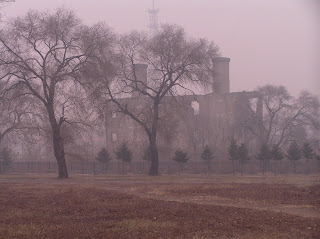Japan's Living Hell - Camp 731
That brown dust would turn out to be fleas, and each one of those fleas (about 30,000 to a Clay bomb) all carried the bacteria Yersinia Pestis...aka The Bubonic Plague.
Those fleas would eventually make their way into people's homes by way of their pets or on the bottom of their shoes where they would sustain flea bites. From there they would end up becoming infected. Since the Bubonic Plague is extremely contagious, it didn't take long before almost all of Quzhou, if not all of it, was wiped out in only a matter of weeks.
But where did those fleas come from? How did Japan manage to get its hands on fleas infected with the Plague?
For that, we need to go back to 1931 when Japan attacked the Northeast region of China known as Manchuria. In 1937, they invaded it.
Many Chinese people were arrested and held as prisoners by the Japanese, crimes didn't need to be committed to be arrested during this time. Japan didn't care, their end goal was to wipe out China, and anyone else who they deemed an enemy, for that matter.
And out of this was born Camp 731.
What started out as a research and public health agency, eventually morphed into a living hell for those inside. Chinese prisoners were used as human test experiments, some being purposly exposed to the elements in order to study frost bite, others being injected with pathogens, such as Yersinia Pestis. Those who didn't show symptoms were shot. Those who did were left to die a horrible, painful death.
But it didn't end there, other atrocities were committed at this test facility. Prisoners were taken out and used as target practice at close and far range to test new weapons. Others had heavy objects dropped on them and others were put in close proximity to a grenade or a bomb. In even more horrible instances, some were operated on...without anesthetic. All of this so that they or their bodies could be studied.
Those injected with the Plague were either put on a gurney where a tube would be inserted into their neck and they would bleed out. That blood would be used to infect others. Other infected patients were put into a sealed room with fleas that feasted on their blood. Those fleas eventually being rounded up where they were put into Clay Bombs and dropped over the town of Quzhou.
Over the years it was in operation, barbaric acts were committed at Camp 731. No prisoner was spared and none came out alive.
In 1945 the American atomic bomb attacks on Hiroshima and Nagasaki happened and shortly after, Camp 731 was closed up.
Any data recorded from the experiments conducted there were mostly all destroyed, which was proof in the eyes of many, that Camp 731 was not a test facility at all, but a torture facility.
Unfortunately, Japan's Camp 731 would not be the only place in the world to use humans as test experiments during WW2. Concentration camps in Nazi Germany conducted horrible tests on many Jews imprisoned there. Russia was also known to have secret test sites where they were said to conduct tests on Prisoners of War. The Russian Sleep Experiment is a well known tale, although it is said to be a work of fiction...or is it?
Camp 731 stands as a reminder, as do the concentration camps, that Evil truly does exist. And if given the means and the facilities, horrible things can and will happen.
In Harbin, China, a museum now stands to cast light on the horrific experiments that were conducted at Camp 731.
History shows us this has happened far too many times. We can only hope, as humans, that we can learn from this, and prevent it from ever happening again.
We can hope...








Comments
Post a Comment